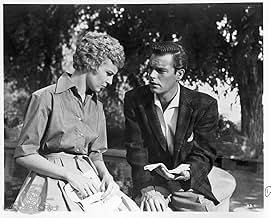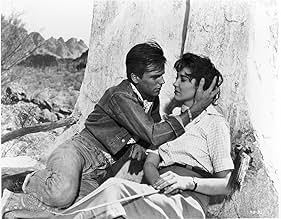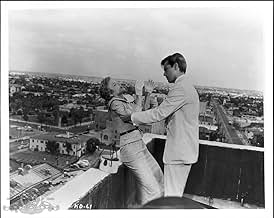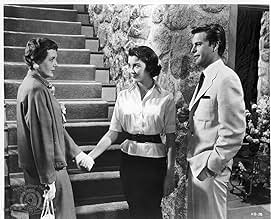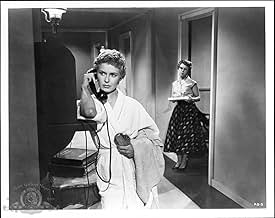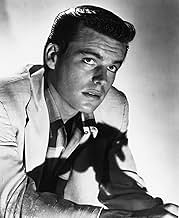VALUTAZIONE IMDb
6,7/10
4710
LA TUA VALUTAZIONE
Uno spietato studente universitario ricorre all'omicidio nel tentativo di sposare un'ereditiera.Uno spietato studente universitario ricorre all'omicidio nel tentativo di sposare un'ereditiera.Uno spietato studente universitario ricorre all'omicidio nel tentativo di sposare un'ereditiera.
Albert Cavens
- Restaurant Patron
- (non citato nei titoli originali)
Robert Ivers
- Student at Murder Scene
- (non citato nei titoli originali)
Mickey Martin
- Student
- (non citato nei titoli originali)
Joe McGuinn
- Chemistry Professor
- (non citato nei titoli originali)
Edwin Rochelle
- Restaurant Patron
- (non citato nei titoli originali)
Jack Stoney
- Policeman
- (non citato nei titoli originali)
Recensioni in evidenza
An evil young man resorts to murder in his efforts to get his hands on an heiress's fortune. Unluckily for him, the heiress's sister and a smart young college lecturer smell a rat ...
This is a sumptuous mid-50's all-American movie, set in a world of sorority houses, open-top cars and drug stores. The boys have shiny, well-oiled hair and the girls wear big skirts. Courting couples meet on the bleachers at the football field between classes.
Shot in cinemascope, the film's aspect ratio means that television (where I saw it) does it a disservice: all too often, dialogues are conducted between two noses at either extreme of the screen. The colour is 'de luxe', so the credits tell us, and indeed the look of the film is rich and bright.
The film is a standard thriller, based on an Ira Levin novel. It is well put together, and has a nice, slinky jazz score, including the theme song (playing on the juke box during one of Bud's dates with Dory).
The opening is impressive. The camera pans around a student's bedroom, neatly setting the scene for us. We hear (but do not see) a girl crying. Gradually, as the characters are revealed, we get the message - Dory has found out that she is pregnant by Bud. She has a wealthy father, but is prepared to forego comfort if the man she loves will marry her. Bud is much more interested in the family money.
Even though Bud is despicable, we find ourselves wanting his scheme to succeed, so cleverly are we drawn into his plan. He surreptitiously studies poisons in the university library, then by a cunning ploy gains access to the chemistry lab. He composes a note in Spanish, ostensibly a piece he needs to translate for his class, then gets Dory to write out the English for him. She doesn't realise it, but she is writing her own 'suicide note'. Gerd Oswald's direction is strong on body language throughout the movie, and we cannot help but see the significance when Dory (played by Joanne Woodward) goes to kiss Bud, and he flinches.
A very young Robert Wagner portrays Bud as a slick, incredibly handsome villain with no feelings. He feigns affection for women, but is capable of none. When he cajoles his mother (Mary Astor) into choosing a tie for him, he craftily changes it for a preferred one when her back is turned.
The director is adept at conveying information without words. When Bud looks at the municipal building and marvels at its height, we know straight away what he is planning. When he is on the roof, the tension is sustained commendably.
Victoria Leith plays Ellen, Dory's sister. In another fine 'body language' moment, we see her subtly shrugging off her father's attempt to comfort her. We gather from this that Ellen blames him for what happened to Dory.
The plot contains some elements which stretch our credulity. If the ending is contrived and highly improbable, at least the incremental steps by which doubt invades Ellen's awareness are cleverly done.
Is it a coincidence that Jeff Hunter (Gordon Grant) and Robert Wagner look so alike? Or are they meant to represent two facets of intelligence - one cold and selfish, the other beneficent and altruistic? In the scene just before the engagement party, they are even dressed identically.
Verdict - A cleverly-executed murder flick.
This is a sumptuous mid-50's all-American movie, set in a world of sorority houses, open-top cars and drug stores. The boys have shiny, well-oiled hair and the girls wear big skirts. Courting couples meet on the bleachers at the football field between classes.
Shot in cinemascope, the film's aspect ratio means that television (where I saw it) does it a disservice: all too often, dialogues are conducted between two noses at either extreme of the screen. The colour is 'de luxe', so the credits tell us, and indeed the look of the film is rich and bright.
The film is a standard thriller, based on an Ira Levin novel. It is well put together, and has a nice, slinky jazz score, including the theme song (playing on the juke box during one of Bud's dates with Dory).
The opening is impressive. The camera pans around a student's bedroom, neatly setting the scene for us. We hear (but do not see) a girl crying. Gradually, as the characters are revealed, we get the message - Dory has found out that she is pregnant by Bud. She has a wealthy father, but is prepared to forego comfort if the man she loves will marry her. Bud is much more interested in the family money.
Even though Bud is despicable, we find ourselves wanting his scheme to succeed, so cleverly are we drawn into his plan. He surreptitiously studies poisons in the university library, then by a cunning ploy gains access to the chemistry lab. He composes a note in Spanish, ostensibly a piece he needs to translate for his class, then gets Dory to write out the English for him. She doesn't realise it, but she is writing her own 'suicide note'. Gerd Oswald's direction is strong on body language throughout the movie, and we cannot help but see the significance when Dory (played by Joanne Woodward) goes to kiss Bud, and he flinches.
A very young Robert Wagner portrays Bud as a slick, incredibly handsome villain with no feelings. He feigns affection for women, but is capable of none. When he cajoles his mother (Mary Astor) into choosing a tie for him, he craftily changes it for a preferred one when her back is turned.
The director is adept at conveying information without words. When Bud looks at the municipal building and marvels at its height, we know straight away what he is planning. When he is on the roof, the tension is sustained commendably.
Victoria Leith plays Ellen, Dory's sister. In another fine 'body language' moment, we see her subtly shrugging off her father's attempt to comfort her. We gather from this that Ellen blames him for what happened to Dory.
The plot contains some elements which stretch our credulity. If the ending is contrived and highly improbable, at least the incremental steps by which doubt invades Ellen's awareness are cleverly done.
Is it a coincidence that Jeff Hunter (Gordon Grant) and Robert Wagner look so alike? Or are they meant to represent two facets of intelligence - one cold and selfish, the other beneficent and altruistic? In the scene just before the engagement party, they are even dressed identically.
Verdict - A cleverly-executed murder flick.
This Cinemascope Technicolor murder drama from 1955 is a great looking film with perfect 50s visuals to carry it well in 2008. In retrospect, I can see the source for both PEEPING TOM and PSYCHO both in 1960 offering the 'shocking' image of a square cut handsome young man as a cruel killer. Of course that idea alone is really a flip on MONSIEUR VERDOUX with Chaplin as the ageing dandy/ dapper killer and even the comedy ARSENIC AND OLD LACE again with the least suspecting type as killers. This version of KISS now-days is reflected in MR RIPLEY too. While it is not up the caliber of that film either, these films all form a group of murder mysteries depicting unassuming types revealed to be murderers. A KISS BEFORE DYING has the very handsome Robert Wagner and equally good looking Jeffrey Hunter pitched front and center for what must have been wild female audience reaction. One scene late in the film set in the desert features Wagner in the tightest jeans imaginable looking like a gay denim version of James Dean. It is all a bit silly in its storyline (university campus killer and rich girl family dramas) but visually it is a real 50s treat. Remade clumsily as a Matt Dillon thriller in 1991, this really is the better version completely because of the great looking cast (incl Joanne Woodward and Mary Astor) and the immensely enjoyable Cinemascope 50s set design and art direction.
According to Alicia Malone, the beautiful and intelligent host at tcm, "A Kiss Before Dying" is considered by Joanne Woodward to be not only her worst picture but the worst picture ever made by Hollywood. Oh c'mon, Joanne, considering some of the turkeys that I have seen with you and your late husband, Paul Newman, you can't possibly be serious. Don't get me wrong. Everyone is entitled to a living, and it's nice work if you can get it. At any rate, considering that Dore is supposed to be a bit of a whining nebbish, Joanne plays the part quite well.
I couldn't help from comparing this story, originating from Ira Levin's novel, to that of Theodore Dreiser's "An American Tragedy" which was adapted to the silver screen as "A Place in the Sun". While Levin's and Dreiser's stories both center on the very determined ambitions of two young men from very modest, if not impoverished, backgrounds, the big difference is that George Eastman (Montgomery Clift) in "Place in the Sun" does not deliberately kill the woman he impregnates. He only WANTS to kill her in the worst way and then does nothing to help her when she, herself, manages to overturn their rowboat on Loon Lake. This significantly distinguishes Eastman from Bud Corliss (Robert Wagner), who, to me, is far less sympathetic and far more depraved than George. The scenes at the closed marriage license offices in both films are also very similar.
The entire cast is excellent, and I would argue that this is among Mr. Wagner's best roles as an unlikely psychopathic murderer. Noteworthy is his brief scene with Mary Astor when he scolds her, his mother, for her wardrobe choice moments before he introduces her to his wealthy girlfriend's family. This one scene defines his character and gives us an important glimpse of at least some of the circumstances behind his motivation. Are the short haircuts of both Mom and Dore a mere coincidence, or is there much more lurking behind that similarity? Mary Astor, an outstanding actor, has always contributed greatly to all of the movies in which I have seen her, including "Act of Violence", "Dodsworth", and "The Maltese Falcon", only a few that immediately come to mind. George Macready, including his distinctively resonant voice, is another seasoned professional whose appearance is a very welcome bonus here. I thought that Virginia Lieth acts very decently, and she looks beautiful, so I don't know why I have never seen her in any other film.
The technicolor photography of cinematographer Lucien Ballard on location in and around Tucson, Arizona, including the campus of the University of Arizona, is exceptional. There is a noticeable crispness to it as it captures the unique architecture and natural surroundings of 1956 Tucson, days that only survive as they are archived by films such as this. Note the copper colored Thunderbird that Dore Kingship drives as well as the corded telephone and the swimming pool ladders of the same color. Someone had a barrel of fun making this picture.
As is the case with any film, there are some peculiar instances, including the reluctance of Dwight Powell at least to attempt to fight for his life. And where is the truck driver at the end? I expected him to appear immediately at the scene instead of hiding in his cab until the police arrive. And does Bud actually push Ellen out of the path of danger, as I believe he does? Also, if Bud's service during the Korean War is a factor behind his behavior, this should have been developed more as it should have but wasn't in the case of George Loomis (Joseph Cotton) in "Niagara", another favorite of mine from the same era.
I couldn't help from comparing this story, originating from Ira Levin's novel, to that of Theodore Dreiser's "An American Tragedy" which was adapted to the silver screen as "A Place in the Sun". While Levin's and Dreiser's stories both center on the very determined ambitions of two young men from very modest, if not impoverished, backgrounds, the big difference is that George Eastman (Montgomery Clift) in "Place in the Sun" does not deliberately kill the woman he impregnates. He only WANTS to kill her in the worst way and then does nothing to help her when she, herself, manages to overturn their rowboat on Loon Lake. This significantly distinguishes Eastman from Bud Corliss (Robert Wagner), who, to me, is far less sympathetic and far more depraved than George. The scenes at the closed marriage license offices in both films are also very similar.
The entire cast is excellent, and I would argue that this is among Mr. Wagner's best roles as an unlikely psychopathic murderer. Noteworthy is his brief scene with Mary Astor when he scolds her, his mother, for her wardrobe choice moments before he introduces her to his wealthy girlfriend's family. This one scene defines his character and gives us an important glimpse of at least some of the circumstances behind his motivation. Are the short haircuts of both Mom and Dore a mere coincidence, or is there much more lurking behind that similarity? Mary Astor, an outstanding actor, has always contributed greatly to all of the movies in which I have seen her, including "Act of Violence", "Dodsworth", and "The Maltese Falcon", only a few that immediately come to mind. George Macready, including his distinctively resonant voice, is another seasoned professional whose appearance is a very welcome bonus here. I thought that Virginia Lieth acts very decently, and she looks beautiful, so I don't know why I have never seen her in any other film.
The technicolor photography of cinematographer Lucien Ballard on location in and around Tucson, Arizona, including the campus of the University of Arizona, is exceptional. There is a noticeable crispness to it as it captures the unique architecture and natural surroundings of 1956 Tucson, days that only survive as they are archived by films such as this. Note the copper colored Thunderbird that Dore Kingship drives as well as the corded telephone and the swimming pool ladders of the same color. Someone had a barrel of fun making this picture.
As is the case with any film, there are some peculiar instances, including the reluctance of Dwight Powell at least to attempt to fight for his life. And where is the truck driver at the end? I expected him to appear immediately at the scene instead of hiding in his cab until the police arrive. And does Bud actually push Ellen out of the path of danger, as I believe he does? Also, if Bud's service during the Korean War is a factor behind his behavior, this should have been developed more as it should have but wasn't in the case of George Loomis (Joseph Cotton) in "Niagara", another favorite of mine from the same era.
A scheming college guy, played by a youthful Robert Wagner, tries to marry into wealth. Complications result in murder. Because of the murder angle, and because the plot centers on Wagner's sly and cunning character, the film reminds me a little of "Dial M For Murder". But, to its credit, "A Kiss Before Dying" has a darker, more brooding, noir-like quality, helped along by a 50's music score that is jazzy and slightly mournful.
Wagner's acting, if not Oscar-worthy, is at least acceptable. But Jeffrey Hunter is miscast, and therefore not convincing, as the pipe-smoking professor/detective. And Joanne Woodward gives a clinging, and altogether too whiny, performance, as the damsel in distress. A couple of interesting, if somewhat implausible, plot twists add impact to the screenplay. The film's conclusion, however, is predictable and just a tad melodramatic.
Overall, "A Kiss Before Dying" comes across as a stylish, very 1950ish, wanna-be classic. It doesn't quite succeed, but is nonetheless worth watching at least once, especially for viewers who like dark, brooding, twist-laden thrillers.
Wagner's acting, if not Oscar-worthy, is at least acceptable. But Jeffrey Hunter is miscast, and therefore not convincing, as the pipe-smoking professor/detective. And Joanne Woodward gives a clinging, and altogether too whiny, performance, as the damsel in distress. A couple of interesting, if somewhat implausible, plot twists add impact to the screenplay. The film's conclusion, however, is predictable and just a tad melodramatic.
Overall, "A Kiss Before Dying" comes across as a stylish, very 1950ish, wanna-be classic. It doesn't quite succeed, but is nonetheless worth watching at least once, especially for viewers who like dark, brooding, twist-laden thrillers.
If you're looking for an adaptation of the Ira Levin book--this isn't it. Also the book would be impossible to film. That aside this is OK murder mystery-thriller. I was lucky enough to see it letter-boxed on TCM--it looks great! However a film dealing with a psycho and murders he commits does NOT need a theme song! Acting is OK--not good, not bad, just OK. The cast is attractive, the film is beautiful to look at and it's an interesting diversion for 1 1/2 hours. So, an OK thriller--nothing really inventive or different about it. At all costs, AVOID the terrible 1991 remake! That one is a TOTAL waste of time!
Lo sapevi?
- QuizThe producers had to fight the Production Code office, or what was left of it by this time, to get the word "pregnant" into the film. Even then, the word was deleted in some parts of the country by local censors. The novel was further bowdlerized by having no discussion in the film between Bud and Dorothy about the possibility of her having an abortion, and the pills Bud gives her are said by him to be vitamins and are in fact simply poison to kill her - whereas in the novel they are intended to induce a termination of pregnancy.
- BlooperNear the end, Gordon is riding to the mine in a Cadillac limousine that has air conditioning, as indicated by small air scoops on both sides behind the back doors. The next shots (after the accident) show a different Cadillac without them. Cars of this era with factory installed air conditioning had half of the system in the trunk, requiring outside air via those little air scoops.
- Citazioni
Bud Corliss: It's not right.
Dorothy Kingship: What?
Bud Corliss: For anyone to love somebody as much as I love you.
- ConnessioniReferenced in Living Single: A Kiss Before Lying (1993)
I più visti
Accedi per valutare e creare un elenco di titoli salvati per ottenere consigli personalizzati
Dettagli
- Tempo di esecuzione1 ora 34 minuti
- Colore
- Proporzioni
- 2.35 : 1
Contribuisci a questa pagina
Suggerisci una modifica o aggiungi i contenuti mancanti



